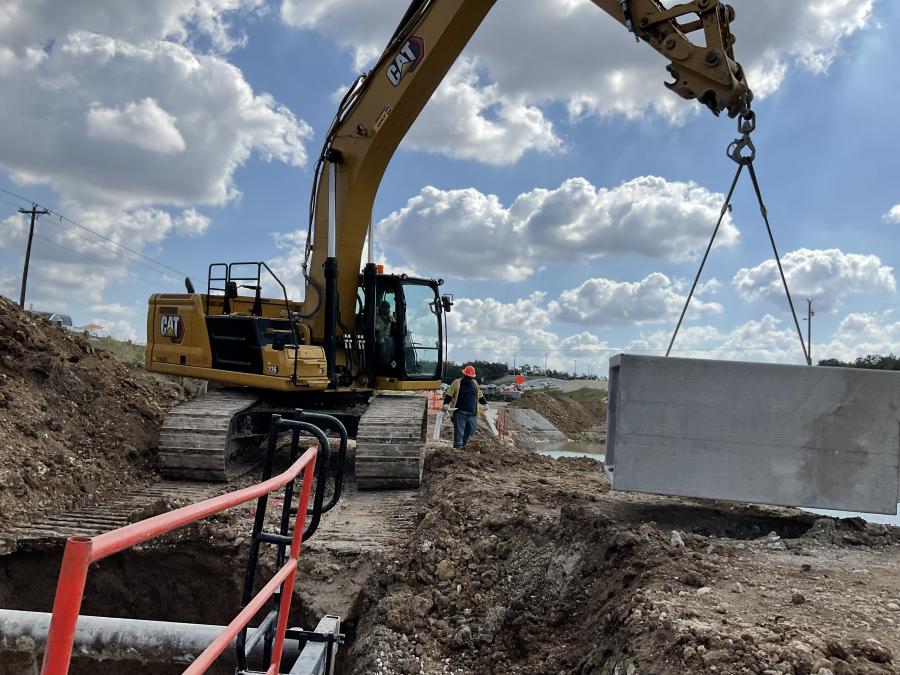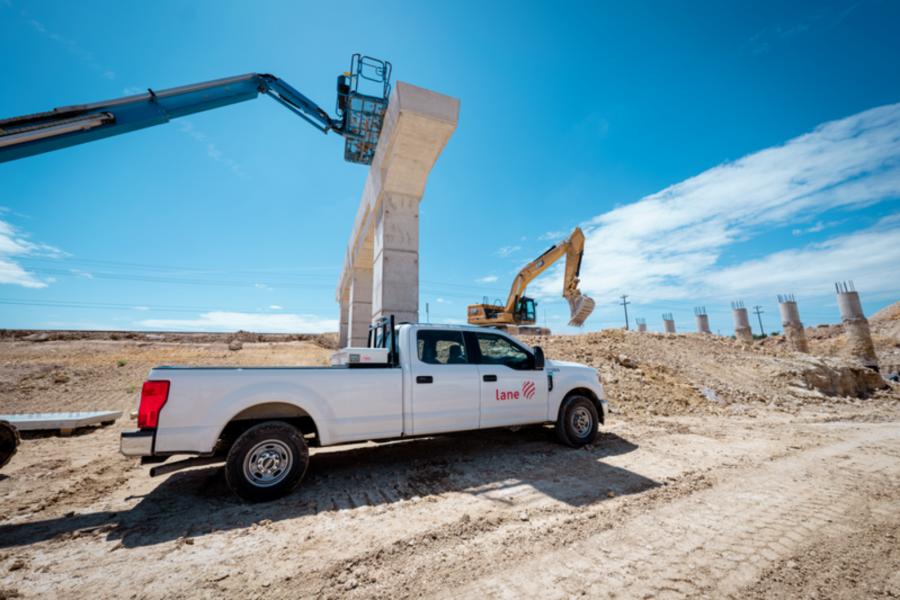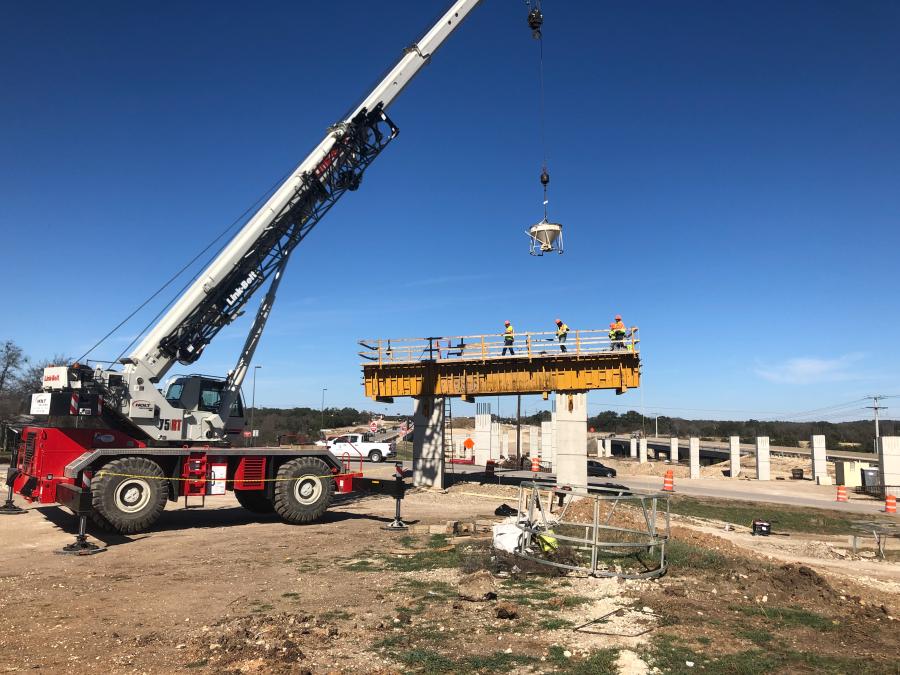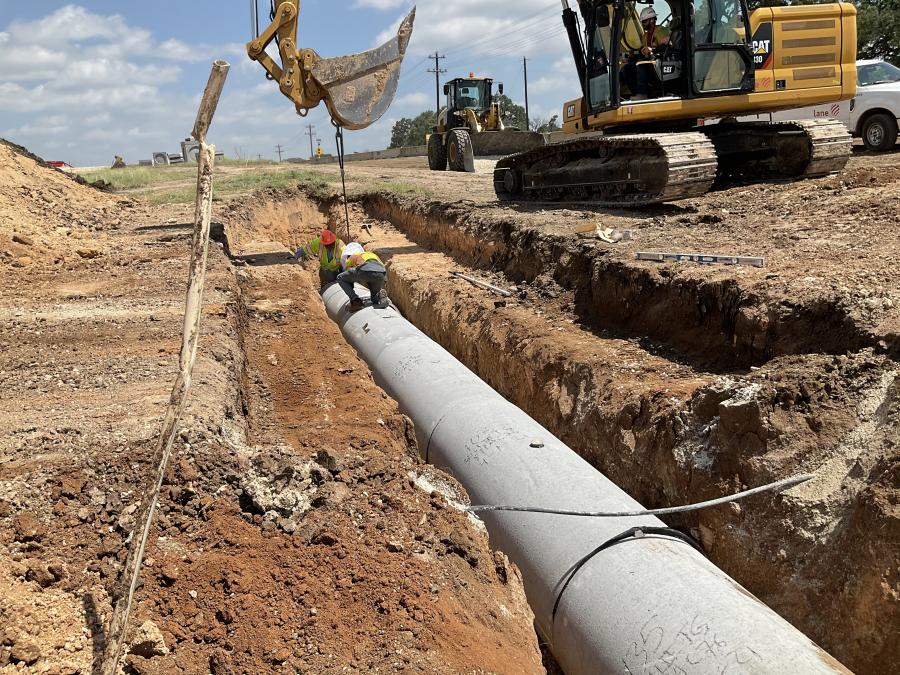Lane Construction Company is extending the 183A Toll Road 6.6-mi. northward from Hero Way in Leander, Texas, to north of SH 29 in Liberty Hill, Texas, as part of the Central Texas Regional Mobility Authority’s 183A Phase III Project.
(Photo courtesy of Texas Central Mobility Authority)
Lane Construction Company is making considerable progress on the Central Texas Regional Mobility Authority's (Mobility Authority) 183A Phase III Project, which began in April 2021, with work focusing on preliminary bridge structures, retaining walls, drainage, waterlines and earthwork.
The project extends the existing 183A Toll Road 6.6-mi. northward from Hero Way in Leander, Texas, to north of SH 29 in Liberty Hill, Texas. It will provide greater mobility and connectivity for commuter and commercial traffic.
Lane Construction Company was awarded a $175.5 million "design-bid-build" delivery method contract in 2020 and expects to deliver the project in 2025.
The project includes the construction of two tolled lanes in each direction, an adjacent shared use path from Hero Way to Seward Junction Loop and aesthetic enhancements along the corridor. The new lanes are being constructed between the existing non-tolled frontage roads, mitigating disruption to the traveling public during construction.
Thus far, Lane Construction has completed and is in the midst of operations for the placement of precast concrete bridge beams (approx. 43-percent complete), bridge drilled shaft foundations (approx. 80-percent complete); bridge columns (approx. 76-percent complete); MSE retaining wall construction (approx. 11-percent complete); roadway earthwork (approx. 50-percent complete); and the installation of drainage systems, conduit runs for roadway illumination and ITS communications.
Project Elements
Commenting on the ongoing work, Lane Project Manager Victor Ancira pointed out that the project is "on schedule and progress is going as planned. Unknown waterline services were discovered during construction. The [Mobility Authority] and Lane collaborated quickly to redesign and build the necessary waterlines with minimal disruption to the construction project."
Lane and its subcontractors have completed 95 percent of the waterlines, 45 percent of the roadway embankments and excavations, 75 percent of bridge drill shafts, detention pond excavation is nearing completion and 39 percent of the prestressed concrete girders have been installed.
"Installation of the drainage pipes was a priority to establish positive drainage and allow for roadway embankments to start," Ancira added. "Bridge and MSE wall construction is beginning at Seward Junction and is working towards Hero Way. The MSE walls are all precast and there are approximately 5.6 miles of walls being constructed with varying depths."
Ancira noted that precast elements include concrete bridge beams, MSE panels and concrete deck panels. Planning is ongoing to set up a batch plant.
In regard to earth work, Ancira said that "Once a large enough section of the subgrade is completed, asphalt and concrete lanes will be installed."
Nine detention ponds are nearing completion.
"Approximately 64,000 linear feet of pipe and box with sizes varying from 12 to 72 inches are being installed," said Ancira. "Some will require cranes to lift them."
Excavators are digging between 2-to-20 ft. deep to install these elements.
"The larger pipes will be installed using a crane," said Ancira, who explained that "utility relocation is progressing."
Over the next year, crews will focus their efforts on bridges, roadway, large excavation and ITS infrastructure and retaining walls. Crews are expected to begin the large excavation and retaining wall system in the area of SH 29 and the fabrication and placement of a pedestrian bridge system across the San Gabriel River.
"Progress along the 183A Phase III corridor is evident each time you drive through the project limits," said Mike Sexton, the Mobility Authority's acting director of engineering. "The team has made tremendous progress over the past year and is on schedule to finish as anticipated, in 2025. During drainage system installation, previously unknown waterlines were discovered. The Mobility Authority quickly coordinated with its design engineer and Lane Construction to revise the design to accommodate the additional waterlines."
The earthwork excavation and embankment will be 1.69 million cu. yds., enough volume to fill 430 Olympic size swimming pools; 3.5 mi. of drilled shaft concrete foundations, with the largest size being 60 in. in diameter; and reinforced concrete pavement for the main lanes that totals 482,870 sq. ft., which equals approximately 8.4 football fields.
"Construction of the project primarily takes place in the center median of the existing highway with temporary concrete barrier separating the work zone from the traveling public," said Sexton. "At any point of time, there are several crews on-site performing varied activities throughout the entire corridor, keeping construction moving and the schedule on track.
"Some operations like bridge beam setting require extensive coordination and lane closures," he added. "Because we aim to impact the traveling public as little as possible, these operations are scheduled for a night shift when traffic volumes are low and multiple lanes and intersections can be closed or detoured, thus helping with haul times and ease of setting up equipment."
A fair amount of precast elements are being used, such as precast concrete retaining wall panels, bridge beams, bridge deck panels, drainage box culverts and inlets/manholes.
"Currently, there are no concrete batch plants on site, but the contractor has proposed that they may install one to provide materials for roadway concrete paving when the time comes," said Sexton.
For the earthwork, subgrade work has taken place for much of the proposed roadway but there is still work to go to get it to final grade.
"To date, the roadway base material has been placed only for a limited portion of the frontage road where a widened shoulder was needed for construction," said Sexton. "The newly constructed 183A Toll mainlanes will be concrete. The existing U.S. 183 lanes which will function as a non-tolled frontage road are asphalt and will receive a fresh asphalt overlay prior to the end of construction."
For the retaining walls and MSE walls, precast sections are being installed.
"Most of our retaining walls are Mechanically Stabilized Earth [MSE] walls, for which there is not a traditional ‘foundation,'" said Sexton. "MSE walls use roadway embankment material to anchor the retaining wall panels via a soil mat system between the walls and connected on the inside of each panel. Our next most common retaining wall style is the soil-nailed retaining wall which also doesn't use a traditional foundation. Instead, the nails are drilled and grouted into the existing, adjacent earth. Traditional spread footing retaining walls are limited to use for some of our water quality ponds. In those cases, the foundations may be just a few feet below finished grade as required for the area."
Bridge Construction
Crews are constructing 17 bridges along the corridor and all 17 "have drill shaft foundations and approximately 75 percent of the piers have been constructed," said Ancira. "The number of lanes varies from two to three. The time to construct a bridge varies depending on weather, traffic conditions, and complexity."
The new bridges consist of 10.9 mi. of precast concrete and 12 mi. of drainage system pipe will be installed.
"These bridges are similar to others in the region and use precast concrete beams to support a reinforced concrete bridge deck," said Sexton. "The pedestrian bridge will be steel framed with an Ipe wood deck and will be constructed to match the style of the existing pedestrian bridges on the existing portion of the 183A shared use path. Approximately 76 percent of bridge columns are complete.

"The total length of all the bridges together equates to 2.02 miles, including the pedestrian bridge which is 660 linear feet long," Sexton added. "The lengths of the bridges vary from 169 feet to 1,160 feet long and carry a different number of lanes depending on the bridge's purpose. For example, the U.S. 183 U-turn bridges at SH 29 will each have just a single lane, while the SH 29 bridge crossing 183A Toll will carry six total lanes. The project also accounts for future lane expansion with foundation sleeves at the bridge abutments and a drainage system sized for a future third lane in each direction."
Bridge construction is subject to variables like material and crew availability, construction sequencing, type of bridge, length of bridge, weather and more.
"All these variables play a part in the length of time to complete a bridge and therefore the timeline from one bridge to the next can vary greatly," said Sexton.
Many detention ponds are currently under construction along the corridor, and more than 64,000 linear ft. of pipe and culvert will be used for the drainage system project wide. The drainage inlets, manholes and junction boxes are precast by Oldcastle Infrastructure based in San Antonio.
"Drainage pipes and structures are buried anywhere from about 8 feet to 40 feet deep," said Sexton." Cranes are involved in setting larger precast structures. Smaller structures can be placed using an excavator."
Over the past year, excavation and earthwork has been a large part of the construction along the corridor, and in the next year, excavation underneath SH 29 will begin.
"For large jobs like these, Lane Construction's earthwork subcontractor is using a Cat D10 dozer; a large, effective piece of equipment not seen on your average construction site," said Sexton. "For bridge beam operations, two 350-ton cranes and a 300-ton crane have been instrumental in safely and quickly setting beams in place. Four manlifts are used to transport the crew from the ground to the bridge caps, and one trackhoe is in place to reconfigure the haul trucks and trailers to keep operations moving."
Utility relocation has progressed smoothly.
"As anticipated, we've been able to prioritize the third-party utility owners' relocation work to minimize impacts to construction efforts," said Sexton. "So far, this work has not impacted project delivery and it appears it will continue to be a non-issue moving forward."
The precast beams are cast by Texas Concrete Partners based out of Victoria, Texas, the concrete deck panels are cast by Bexar Concrete Works, the MSE wall panels are cast by Tricon, and the steel trusses and overlook platforms for the pedestrian bridge over the San Gabriel River will be fabricated by Contech Engineered Solutions.
The Lane management team also includes Vice President Jason McLear, construction west; Senior Project Engineer Benjamin Jablonksi; and Project Superintendent Julian Sepeda.
"The Mobility Authority, the contractor and the CEI have a great working relationship," said Ancira. "Open and transparent communication is key to working successfully together."
There are approximately 105 Lane and subcontractor personnel on-site. The main subcontractors are Ranger Excavating for earthwork activities; Beaird Drilling for bridge drill shafts; SICE for electrical and signage components; D Guerra Construction for waterline utilities; and Oscar Orduno for temporary special shoring.
New materials being brought in include more than 230,000 tons of concrete, more than 21,000 tons of asphalt paving, 325,000 cubic yards of MSE wall aggregates and 148,000 tons of concrete paving aggregates.
Additional equipment on-site includes seven large excavators, 11 wheel loaders, four rough terrain cranes, and six dozers.
"The major wear and tear issues that occur are potholes," said Ancira. "These occur along the existing southbound and northbound lanes of 183A. Repairs are made once it is safe and when minimal impact to the traveling public can be expected. We have on-site mechanics and when needed, third-party mechanics are brought in."
In the Texas area, Lane purchases and rents equipment from local and regional dealerships.
The traffic management plan is working well.
"The project is phased to shift the current lanes toward the outside while the majority of construction activities takes place in the center median," said Sexton. "Once we shift the lanes back to their original positions, they'll remain there in the final configuration. With the majority of work focused inside the median of the existing lanes, we've managed to maintain nearly full lane capacity during construction so far. The largest anticipated temporary reduction in traffic capacity will occur in the future, when excavation and bridge work at SH 29 occurs." CEG
Irwin Rapoport
A journalist who started his career at a weekly community newspaper, Irwin Rapoport has written about construction and architecture for more than 15 years, as well as a variety of other subjects, such as recycling, environmental issues, business supply chains, property development, pulp and paper, agriculture, solar power and energy, and education. Getting the story right and illustrating the hard work and professionalism that goes into completing road, bridge, and building projects is important to him. A key element of his construction articles is to provide readers with an opportunity to see how general contractors and departments of transportation complete their projects and address challenges so that lessons learned can be shared with a wider audience.
Rapoport has a BA in History and a Minor in Political Science from Concordia University. His hobbies include hiking, birding, cycling, reading, going to concerts and plays, hanging out with friends and family, and architecture. He is keen to one day write an MA thesis on military and economic planning by the Great Powers prior to the start of the First World War.
Read more from Irwin Rapoport here.
Today's top stories





















